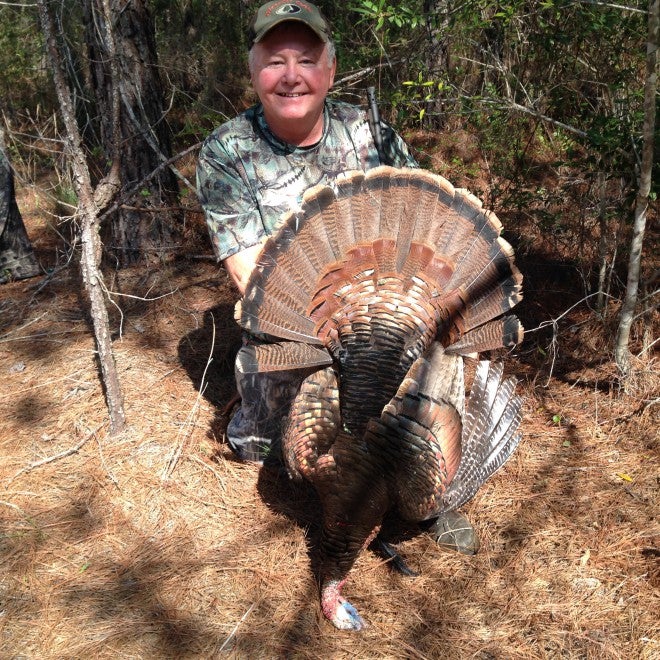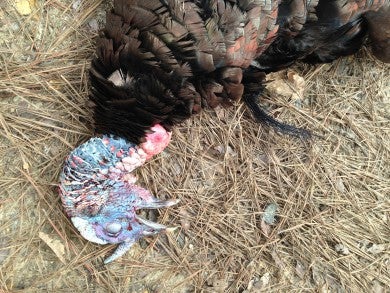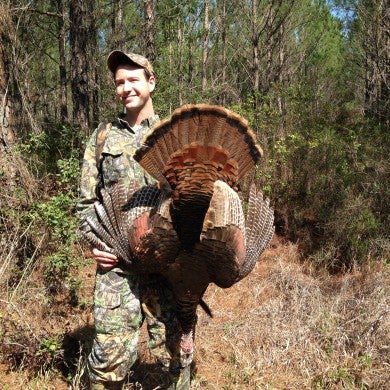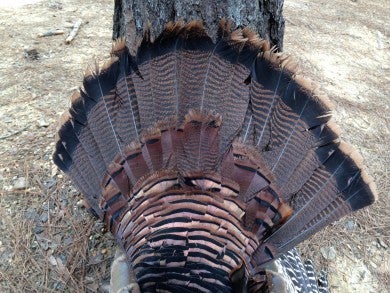This Turkey Flew the Coop
Bob McNally 04.12.16

This tale has a good ending. But it could have gone very bad without the determination to never give up on wounded game.
I was in a ground tent blind recently hunting turkeys at a spot I know well and have taken several good toms from over the years. It’s a place where turkeys often don’t show at first light. They take their time ambling to the place from a distant roost. Patience is the key to success there.
So at 9:30 a.m. I wasn’t too flustered not to have heard a tom gobble. It had been a muggy, buggy morning with no real turkey talk filling the air. A pair of hen turkeys cruised through the area soon after dawn, but when they departed at 8:30, it was a long time without much action.
The best hunting routine at the spot is to call softly like a hen turkey every 15 to 20 minutes, talking sweet and sexy hoping to lure a love-crazed tom within shotgun range.
I had just scratched a few hen notes with a slate call, when far off through an open stand of mature pine trees I saw movement, and a bright red head of a tom turkey materialized.
The bird was 100 yards away, moving steadily toward me as I reached for my Ithaca Model 37, a gun nearly as old as me. As I brought the shotgun up to my shoulder, I saw another mature tom 10 yards behind the first bird. Both were coming quickly straight to me as if pulled by a rope.
They were coming so fast, heads bobbing and turning to find mate-crazed hens, that they seemed to be racing to be first at the singles bar.
Finally, at 40 yards, the first tom slowed. He stopped at 35 yards on a terrain high spot. His long neck went up in periscope fashion as far as he could stretch it, looking intently for the fake hen he heard yelp.
Though the Ithaca was up and on target, I considered waiting and letting the bird get closer before shooting. But 35 yards is a chip shot for that old gun, so I settled the fiber-optic sights on the bird’s neck–except I couldn’t get a clear sight picture of the red and green fiber optics.
Inside the shadow-filled tent blind, the sight didn’t have much ambient light to gather, so getting a bright, crisp sight picture was difficult. The sights were very hazy.
For long seconds the tom turned its head left and right looking for hens while I struggled to see the sights well and get the gobbler lined up.
Knowing the bird wouldn’t stand still for long, nor would his bachelor buddy behind him, I squeezed the trigger and the Ithaca roared.
To my open-mouth astonishment, a turkey took flight. I was so startled by it, I figured it was the second, more distant turkey that had taken to the air, believing the bird I’d targeted had crumpled dead at the shot like countless toms before it had.
Except the bird that flew was the one I’d targeted.
I watched the tom go straight up as tall as the pines, then bank in the air and sail back away from my blind toward where the birds had first appeared. I made a mental mark of the place I last spotted the tom as it flew, then got out of the blind fast and to the spot where the bird had been standing when I shot.
At that spot over a dozen turkey breast feathers were strewn on the ground, showing I’d hit the bird hard. Not good enough to anchor it, however, as it had flown away.
For the next 20 minutes I walked and looked and tried to find the bird, but to no avail.
It was 10 a.m., the scheduled time I was to pick up my son Matt from his turkey hunting location several miles away.
Dejected and angry at myself, I drove to get Matt, picked him up, and at his insistence we returned to where I’d shot at my turkey.
We arrived at the place about 11 a.m. I showed him the feathers on the ground, and we began a thorough grid search of the area.
“You always said ‘never give up if game is hit, but not recovered,’ and we’re gonna stay here until we find that gobbler,” he said strongly.
And that’s what we did.
For 30 minutes we walked rows and rows of planted pines, looking carefully into thickets, tangled briers, and gallberry patches, trying to find a feather or track from a bird that had passed that way.
Finally, Matt said he spotted something on the ground 70 yards away in an open pine lane.
“Yep, there he is.”
The bird had traveled about 300 yards from where it had been hard hit. It may have flown and fallen or landed and ran before succumbing. But the 17-pound gobbler with 10-inch beard was collected and we were elated to recover it.
“Never give up,” Matt reiterated, as he held the bird smiling. “But it might be time to put a scope on that old Ithaca.”
He is right on both counts.


